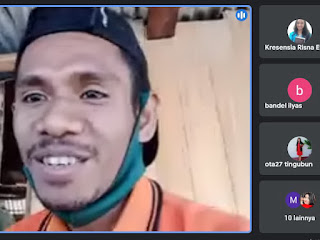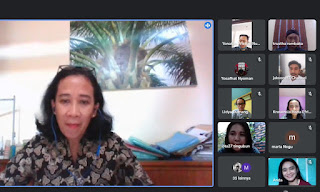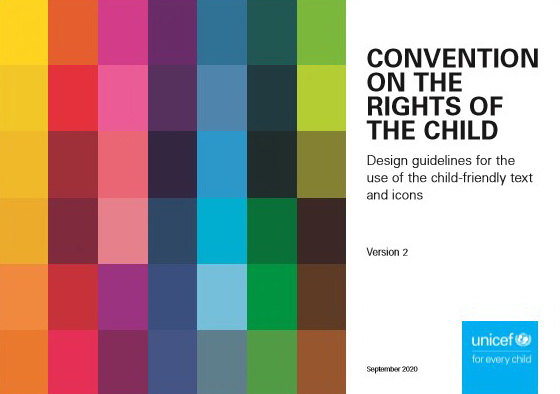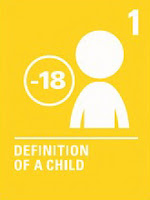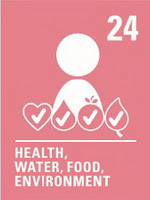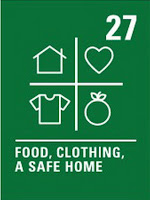Promoting Children's Rights Through Video
Tuesday, 31 August 2021by Kresensia Risna Efrieno
By: Kresensia Risna Efrieno.
Have you ever found a problem in your place of origin? Have you ever thought about expressing your concern about it? Or documenting it on video? Nowadays, videos are highly liked to be studied and video-making skills are liked among young people, especially students amid technological advances. The combination of technological advances and revealing reality has become Stube HEMAT Yogyakarta's strategy in the Peace and Justice Program to hold short video competitions for students throughout Indonesia. This competition is not just about telling events or data into an interesting video-shaped work but encouraging students to recognize children's rights, the reality of the problems faced by children in their respective regions.
This short video competition starts from 6/08/2021 until two weeks for participants to work on videos. Twenty student participants from various study programs and various regions in Indonesia took part in this competition. This activity is also one of the challenges for the Stube HEMAT Yogyakarta team to recruit participants and provide assistance during the PPKM period. However, this is not an obstacle, the team and participants continue to assist online. The participants who took part in the competition started the competition process by studying together with the Stube HEMAT Yogyakarta team as a companion to understand Children's Rights, then mapped out problems related to the implementation of children's rights in their area. From these findings, they explored why it happened and what alternatives to overcome these problems. Then, they designed a narrative and made it in the form of video recordings, either in the form of reports, narratives to short films containing creative and in-depth messages to promote children's rights in Indonesia.
At the end of the deadline, nineteen videos reveal the reality of the problems faced by children in various regions in Indonesia, including from Manggarai, Alor, Sumba, Nias, Humbang Hasundutan (North Sumatra), Gunungkidul, Sukoharjo, West Sulawesi, and East Lampung. The video making required struggles because the participants have to map the situation in their area, analyze, design scenes and record to edit videos, even they have to overcome the limited communication networks. However, they completed the video according to their capabilities.
Considering an objective assessment, Stube HEMAT Yogyakarta involved practitioners who are competent in their fields as juries, including Ifa Aryani (Indonesian Child Protection Commission (KPAI) for the city of Yogyakarta), Bandel Ilyas (actor, director, casting director), and Richard Panggabean (multimedia, recordings, and audio-visuals). Based on the content, artistic, and appearance aspects, the top five videos emerged, namely, 'Why should I?' by Jakson Hamba Tana from East Sumba as first place; “Have My Rights Been Fulfilled?” by Merlince Pauline Maure from Alor as second place; “Mama, I Want to Go to School” by Angelina Delviani from West Manggarai as third place; “Why Am I Getting Married?” by Thomas Yulianto from East Lampung as fourth place and "Don't Leave Me" by Eufemia Sarina from Manggarai as fifth place.
From the juries' response, it was revealed that they appreciated the efforts of the participants to reveal the reality of the problems faced by children in their hometown. However, the participants must continue to improve the quality of the video, starting from formulating ideas, compiling narratives, taking pictures and transitions, sound volume, using pictures that are part of the video. Young students need not to be afraid to express themselves. Starting to sharpen sensitivity to see reality, be creative in utilizing technological advances, and dare to voice the call of humanity, especially children's rights amid civilization.
Young Generation Ono Niha is Exploring the Children’s Rights
Wednesday, 18 August 2021by Putri NV Laoli.
By Putri NV Laoli.
As part of the younger generation of Ono Niha, Nias, North Sumatra, and have learned the children’s rights, I invited the young Ono Niha to have online discussion about children's rights to Commemorate the Republic of Indonesia's 76th independence (18/8/2021). The initiative got responses from young people, from students, high school graduates, and those who are employed. Understanding about human rights, especially important children's rights, is important because of human rights that cannot be revoked. Life is a fundamental right that humans are born with and starts from the freedom of children to their rights.
Starting the discussion, Franciscus Harefa, a youth figure in the community of Ono Niha, said the stepping point of the discussion: "the purpose of this discussion is to establish a relation, as well as a media for online discussion to reach young Nias and sow a habit for discussion. So the youth will have new insight and knowledge and concern for the environment."
Then I introduced the concept of 'child's rights, the idea of children rights appeared at the end of the First World War and continued after the Second World War as a reaction to the suffering that occur after the wars, especially faced by women and children. The struggle for the rights of the child was marked by Eglante Jebb in 1923 through the Declaration of Children’s Rights that have 10 point statements Rights of the Child. It was adopted by the League of Nations and known by the Geneva Declaration and then the General Assembly of the UN finally adopted it. While in Indonesia, the concern for children began since the founding of the Indonesian Women’s Congress in 1946. Then in 1951 Indonesia Woman Corps (Kowani) held a congress, and established a National Childhood Day. This led to the start of the National Child's day on July 23 through The President Decision 44/1984 and on September 5, 1990, the Government ratified the Convention on the rights of the child through The President Decision no 36/1990.
As time goes by, the appreciation to the rights of the child grows but, unfortunately, many people have not been 'aware’ of the issue which led to violence against children who should be protected, children who should be educated and have been dropouts, children work hard with have no time to play, recreation and to get sick because of bad habit, food, and unlivable home. Then, who is responsible for fulfilling the child's rights? Answering this certainly begins with who is in the closest circle of children, like parents, families, local communities including the local government to the central.
This discussion was so interesting when the participants gave their responses, Ilham Trihayono a management student of Sultan Ageng Tirtayasa University told his experience with a 7-year-old suffering from illness PDD-NOS, a type of autism. "Children with autism often get bullied, and sometimes get no 100% protection because of bullying at school, so parents tended to be protective by forbidding he/she to play." On the other hand, Andre one of the participants criticized that the real target of information on the rights of this child, a person over 18 years old, a parent, or a government, and whether the rights of the child should be deprived? If a child knew the rights he or she would become more difficult to manage.
To be sure, the adults should know the rights of the child and implement it as their responsibility to establish child welfare. It looks simple but will impact the life of a generation, especially to a better Ono Niha generation.
Giving More Insights of Young Nias about The Children’s Rights
Sunday, 8 August 2021by Putri NV. Laoli.
By: Putri NV. Laoli.
Have you thought about the term of a child? In various literatures, children are models of adults. Just as adults demand that their rights should be fulfilled, so the children have rights to be fulfilled even though they are not aware of it. The adults should ensure that the rights of the child are fulfilled and they are protected from the violence that threatens them. I discovered the reality from Stube HEMAT Yogyakarta's discussion about "The Children’s Problem in Indonesia and Striving for the Rights of the Children" (5-6/8/2021).
From the discussion, I was curious to find information by observing the environment that related to the rights of the children. The Ministry of Women's Empowerment and Child Protection (PPPA) noted 5.463 cases of child abuse until July 2021. Based on the data from the ministry of PPPA's online information system for Women and Children's Protection, the majority of child abuse cases occurred in households. While others take place at schools and public places. The kind of violence covered physical, psychic, displacement, trafficking, and exploitation even sexual violence. The violence affects children of various ages, while reported cases are common in high school/equals.
One of the causes of the cases is minimum understanding and awareness of the rights of the child among adults, so it needs efforts for socialization among the society. I took a simple step to promote an understanding of the rights of the child, especially in my hometown, Nias, although I am currently in Yogyakarta. I encouraged my sibling, Kefas Charity Laoli, to talk with local youths. Although he is still at high school, he responded positively and vigorously moved local youths to learn the rights of children in Nias through online meeting (07/08/2021), held in the community center of the Gido District, Nias Regency, North Sumatra. At least eight youths from various schools joined it.
I started the session with a simple game as ice-breaking and helped participants easily understand the topic. Then they looked at a brief history about the emergence rights of child concept at both international and national levels, the diversity of rights of children, and those who are responsible to ensure those rights are fulfilled, including parents, families, communities, and governments. At the end of the discussion, I invited them to map the children's rights implementation among themselves by checking the statements that have been shared. Then, they came to realize and recognize that some things remain unfulfilled from the 42 rights of children according to international conventions. From this phase, I ignited them to reflect on what causes the rights of children to be unfulfilled and what can they do as teenagers? Until one understanding came up that youth should actively participate in the child community of their area as a means to campaign for the children’s rights both in the family and in the community, including balancing the rights and duty of the child.
The process of the activity made me more convinced that children need an adult's touch to introduce their rights since early age. One of the participants, Sri Zebua gave feedback, "Through this activity, I learned my rights and obligations as a child either in the family-community, or the government." Another participant, Cici Halawa said, "I didn't realize that there were children's rights until I found out that I had learned a new topic besides school subjects in this activity."
One simple action that touched the grassroots will awaken consciousness and enthusiasm to life. The adults and governments work together to realize a child's rights and create children growing environment and space that are conducive, safe, and away from violence.
Revealing Reality Through Video
Saturday, 7 August 2021by Yonatan Pristiaji Nugroho
By: Yonatan Pristiaji Nugroho
Video is a technology that displays sound and moving images to convey a message. Through video, messages can be in the form of news or events based on facts or stories that can educate and provide information. Video creations can be displayed in several forms, such as TV channels, Movies, Youtube, Instagram, or Tiktok. Each video presented has its specific goal and purpose.
The “Peace and Justice” program done by Stube HEMAT encouraged participants to see and understand peace and justice, especially violence against children, human trafficking, and sexual violence that occurs. Furthermore, Stube HEMAT Yogyakarta provided them an opportunity to participate in a discussion (Friday, 6/8/2021) with the topic of the program “Peace and Justice” in the form of a video. This discussion which was followed not only by students living in Yogyakarta but also from outside the island, such as Alor NTT, Manggarai NTT, Sumba, and Kupang trained them to develop video-making techniques. The discussion was conducted online due to government's regulation during the pandemic.
In collaboration with Bandel Ilyas, a film practitioner, an actor (theater and film), director, and a casting director on various films and other works, such as a short movie entitled Rumah Pohon, Unbaedah, Pulang Tanpa Alamat, Segawon, or film entitled Filosofi Kopi, Demi Waktu, Bumi dan Manusia, and Mantuk which he directed. In this discussion, he revealed the process of making films/videos. What should be considered in making a video? Such as determining the theme and concept of the video, writing the film statement as an idea for scriptwriting, making a shooting schedule for the shooting schedule and shooting list to record what events will be obtained, then editing the script as a framework for the film/video to be made. These steps are very important to combine raw video into a unified visual image having a message and purpose. The message conveyed by each video is specifically based on the type, such as comedy, education, documentary, or fiction video.
In conversation with resource persons, the participants asked many questions about making videos and some participants even had never made creative videos at all. One question from Isna, a participant, "Can the data be added to strengthen the dramatization?" He responded that like in a reality show, a documentary video could be dramatized by the narration and the narrator. Dramatic value is the totality of the journey and conveying the plot and message of the film to the audience. The power of narration and narrator is very influential on dramatization. Another participant, Rivaldo also asked how to show personal experience in the video. Ilyas explained that for a personal experience, the aspect of objectivity should be expressed more rather than subjectiveness, where the scripts should come from factual events.
Through the discussion, the participants are expected to learn in making creative and beneficial videos for the audience. They are motivated to make their video creations, both from personal experience and concepts made before. A good video provides education and a message for the viewer. Positive messages lead not to bring down and offend other parties or people.
Stube HEMAT Yogyakarta invited the participants to participate in the short video competition about Children's Rights and the reality faced by children in Indonesia. Keep on sharpening awareness to see social realities and reveal them in videos. Come on, students are capable!
Exploring the Children’s Right and the Challenges in Indonesia
Friday, 6 August 2021by Thomas Yulianto
By: Thomas Yulianto
According to the Ministry of PPPA (Woman Empowerment & Child Protection), the number of violence against children in Indonesia in 2021 is high, reaching 3.122 cases, and most of them are sexual violence. Its high number of violence against children became the stepping point for Stube HEMAT Yogyakarta to discuss with a theme "Mapping Children's Problems in Indonesia and Promoting Children's Rights." The discussion was held online (Thursday, 5/8/2021) and was attended by students from various regions, Nias, Medan, Bangka Belitung, Lampung, Java, Sumba, Manggarai, Alor, Maluku, and Raja Ampat.
Ariani Narwastujati, S.Pd., S.S., M.Pd., the Executive Director of Stube-HEMAT was the training resource person. She has experience in international training on Children's Rights at Stube Nord, Hamburg, Germany. In the discussion, she asked the participants about what they would fight for regarding the children's rights? Most responses focused on the rights of education and protection. The level of education rate in the village is lower than in the city, due to low understanding of children's rights among parents, such as getting a 9-years-minumum education. In some participants’ areas, the violence against children occurred because of the habits of the parents as the example from one generation to other generation, so that the rights to protect children need to be fought for.
Ariani presented the International Convention on the Rights of the Child, which began in 1989 when the world's governments gathered and made a policy to protect children by the international legal framework of the United Nations. Children need care while growing, learning, playing, developing, and to be treated fairly. There are 42 points in the children’s right in the convention and they are ratified into 10 point of children's rights in Indonesia. They include the rights to a name or identity, protection, have citizenship, food, health, recreation, education, play, participation in development, and equality. The rights to child protection in Indonesia itself are regulated in the Law of the Republic of Indonesia, No. 23 of 2002.
After receiving material on the International Convention on the Rights of Child and children's rights in Indonesia, the participants are well informed with children's rights. It could be heard from the feedbacks of the participants' experiences that occurred in various regions in Indonesia showing children who suffered from physical violence when they were assumed to be disobedient, ignorance by busy working parents, unhealthy home environment because of the smoking parents, and traditional needs are prioritized over providing children's educational needs. From the findings of these cases, the participants learned that children's rights had not been fully fulfilled and discovered that not everyone understood children's rights. The understanding and awareness of children's rights were important for adult in the child's environment to provide space for children's growth and development and learning. These various incidents may be caused by the low knowledge and awareness of children's rights besides the influence of life habits, education level, and culture. It is expected in the future that through intense education and socialization to the community about children's rights, there will be better understanding and realization of children’s rights.
Through the discussion, the participants were challenged to involve themselves as agents of change, to fight for children who have not yet get their rights in their childhood. They are motivated to implement children's rights when they become parents somedays. Long live Indonesian children!
Web Archive
2024 (6)Total: 449

































